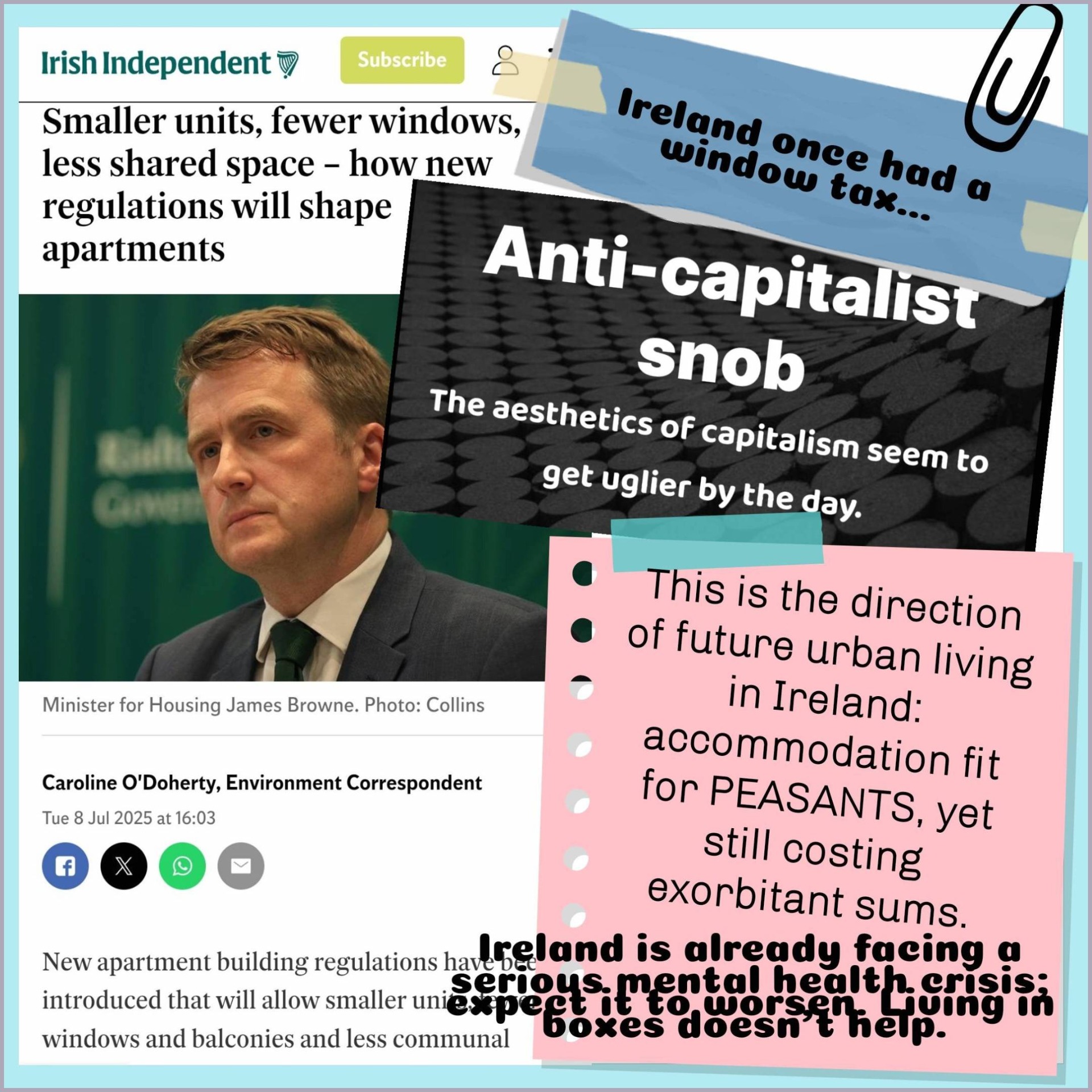A City Without Soul: Ireland's Housing Policy
From the perspective of an artist, and indeed from the perspective of any person who values their surroundings, the latest planning guidelines from the Irish government feel less like a solution and more like a profound act of negligence. The new "Planning Design Standards for Apartments," ostensibly designed to solve the housing crisis, represent a dangerous and short-sighted trade-off. They sacrifice the fundamental value of aesthetics, cultural identity, and mental well-being for the sake of a quick fix, with the added and more insidious risk of creating a new generation of social ghettos. A city's aesthetics are not a luxury, they are a public good.
As an artist, I am acutely aware of how my environment directly influences my work, my mood, and my very sense of being. But this is not unique to artists. Every person's mental well-being and happiness are intrinsically linked to the quality of their surroundings. A broken, dirty, and uninspired urban landscape can breed feelings of stress, anxiety, and a sense of decay. A beautiful, well-designed city, with balanced architecture, public spaces, and natural light, does the opposite—it fosters pride, community, and a deeper sense of belonging. The government's new policy seems to willfully ignore this core truth.
The Policy: A Race to the Bottom That Creates Social Division
The policy itself is a list of compromises that will inevitably lead to a visually sterile city and, more dangerously, a two-tiered housing market defined by class. Key changes include:
Smaller Living Spaces: The reduction in minimum apartment sizes will lead to cramped conditions, limiting the ability for residents to feel comfortable or for families to grow. Studies have shown a strong link between such conditions and lower mental and physical health outcomes.
Reduced Amenities: By easing requirements for private open spaces like balconies and patios, the policy removes vital connections to the outside world, robbing residents of fresh air and a chance for quiet contemplation.
Fewer Windows and Natural Light: The new, relaxed standards for dual-aspect apartments will create darker homes, a condition scientifically linked to negative mental health outcomes.
De-emphasis on Community: The removal of mandatory communal facilities means that new developments could become isolated clusters of residential units rather than genuine communities, further contributing to social fragmentation.The cumulative effect of these changes is a blueprint for social inequality. By allowing for the creation of low-standard housing, the government is essentially enabling the development of modern ghettos—areas of high-density housing that lack the essential components of a livable community. These areas, which are likely to house low-income families and those in subsidized housing, will become physically and socially segregated from the rest of the city, perpetuating a cycle of disadvantage and social isolation. This is not an accidental consequence; it is a predictable outcome of policies that prioritize profit over people.
The Economic Paradox: High Spending, Unseen Outcomes
This leads to the perplexing paradox of Ireland's housing crisis: high government expenditure without tangible, positive results. Recent reports show that Ireland's government housing expenditure is among the highest in the EU on a proportional basis. This raises a crucial, and often cynical, question: if the money is being spent, why can't we see the results in our streets and communities?
The answer points to systemic failures, not a lack of funds. The money is being channeled into an ineffective policy that heavily subsidizes the private market through schemes like HAP, inflating rents and land values rather than building public homes. This spending is also lost to inflated construction costs and a convoluted administrative system. This reality fuels a deep-seated public suspicion of incompetence and regulatory capture, where the government's policies are shaped more by the powerful construction and development lobbies than by the needs of the people.
This is compounded by the use of Modified Gross National Income (GNI*), a statistical tool that, while useful for economists, can create a misleadingly rosy picture of state spending when compared to other EU nations using the standard GDP. This "apples and pears" comparison risks placating citizens with an illusion of progress while the real crisis deepens.
A Lost Opportunity to Build a National Identity:
Perhaps the most tragic consequence of this short-sighted policy lies in the historical context of Irish identity. For centuries, native Irish architectural traditions were suppressed under colonial rule. The grand Georgian squares and "Big Houses" of our cities, while beautiful, are a complex legacy of a colonial past. In the post-independence era, Irish architects have been striving to create a modern, uniquely Irish architectural identity—one that is rooted in irish culture, landscape, and values.The new policy squanders this hard-won opportunity. By prioritizing generic, cost-cutting designs, it actively hinders the development of a new, national vernacular. The resulting buildings will not reflect a modern Irish sensibility; they will simply reflect the lowest possible construction standards. It is a form of architectural colonialism, not by a foreign power, but by a domestic government that has chosen to prioritize commercial interests over cultural expression and long-term societal well-being.
In a world that is increasingly globalized, a strong and distinct cultural identity is more vital than ever. A city's architecture is its most visible form of cultural expression. By failing to invest in beautiful, well-designed, and culturally sensitive buildings, Ireland is failing to build a modern identity and a future that its citizens can be proud of. This isn't just a political misstep, it is a profound artistic and social tragedy. The government's approach is a dangerous gamble that not only compromises the present but actively designs the inequalities and architectural failures that future generations will be left to inherit and endure.


